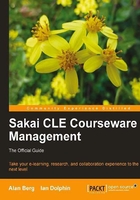
What this book covers
Chapter 1, What is Sakai, is an introduction to Sakai.
Chapter 2, Feet First: Running the Demo, explains how to install a demo version of the Sakai CLE. One way to approach understanding the content of this book is to have the demo running while reading the chapters on specific toolsets.
Chapter 3, Sakai 2.x Anatomy, explains the underpinning technologies and how system integrators have deployed Sakai at large scales in practice.
Chapter 4, My First Site, describes how to create and manage your first site.
Chapter 5, Enterprise Bundle Tools and Quality Assurance, covers the many different site tools that are available to you and how quality is defended during their development.
Chapter 6, Worksite Tools, discusses the various types of tools and shows how they are used in sites.
Chapter 7, Contributed Tools, covers tools that have been built by third parties to fulfill specific needs. These tools are not found in the standard Sakai demonstration, but do have a lot of potential for improving a student's online learning experiences.
Chapter 8, Putting Sakai to Work, discusses how to use tools in combination to create a better online learning experience.
Chapter 9, The Administration Workspace, introduces the administrative features of Sakai.
Chapter 10, Web Services: Connecting to the Enterprise, discusses the Sakai web services for creating and maintaining users, sites, and groups and lists a wide variety of existing services explaining how to discover and connect to them.
Chapter 11, Tips from the Trenches, is an advanced chapter that explains concepts that you need during first-time Sakai deployments. In this chapter, you will find an overview of third-party frameworks on which Sakai, how to manage and monitor Java, and interviews with various experts.
Chapter 12, Common Error Messages, is about common error messages in Sakai and how to deal with them.
Chapter 13, Show Cases, presents ten international case studies showing Sakai at its best.
Chapter 14, Innovating Teaching and Learning with Sakai, takes a look at what makes an award winning course, award winning.
Chapter 15, A Crib Sheet for Selling Sakai to Traditional, discusses motivations for deploying open source applications in higher education environments, such as at the University of Amsterdam.
Chapter 16, Participating in the Sakai Community, discusses how to interact with the Sakai community successfully.
Chapter 17, The Sakai long-term vision, is a discussion about the future of Sakai.
Appendix A, Terminology, defines the many terminologies and concepts used in Sakai.
Appendix B, Resources, explains the best practices, communities, tools, and training material to help others learn and use Sakai effectively.